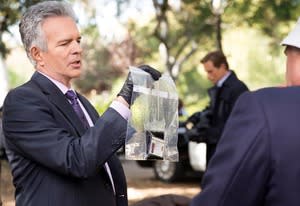Major Crimes Creator James Duff Previews "Return to Sender"

We have arrived at the last two episodes of Major Crimes first winter season, during which we will answer several questions that have accumulated during the previous seven months, and unravel the mystery behind the threatening letters written to Captain Sharon Raydor and her material witness, Rusty Beck.
And we will face two of the final tests of character as this curious case unwinds in unusual fashion. Like The Closer before it, Major Crimes does not often depict serial killers. That's because, for whatever reason, serial killers are hard to come by in Los Angeles these days, and our desire to be authentic occasionally draws tight margins around where our story can go.
But we pulled out a lot of our self-imposed stops when creating "Return to Sender," and I think we pulled those stops out properly. Remember that Major Crimes has not only been working the homicide beat, but also depicting the ordeal of the witness in our Byzantine justice system. We are poised to bring a significant part of that ordeal to an end. But at what cost?
Captain Sharon Raydor has stepped into the parental vacuum, and worked hard to prepare Rusty for both his day in court, and to participate as "Number One" in a police operation aimed at drawing out the person writing them threatening letters. That preparation is over; the crisis is met. And, as it often does in life, crisis reveals our true character.
So it does, too, for one of the very worst murderers we have ever met in the entire run of either series. As our story unfolds, some distinct parallels will emerge between the hunter and the hunted; every member of our experienced team of detectives will end up struggling to find the killer before he breaks down LAPD defenses and accomplishes his mission. And the killer is in crisis, too, despite having already murdered several people without ever drawing unwanted attention from authorities. You can look someone up in a criminal database all you want; if they have never been arrested or tried for a legal offense, you are unlikely to match their prints to any you may grab at the scene of your investigation. The ability to murder several times without alarming anyone would indicate a highly organized mind with an obsessive attention to detail. Like Rusty Beck, the crisis in which our young killer finds himself is one he has prepared to meet. And one Sharon Raydor and the rest of her team inside the LAPD train to face every day of their lives.
I owe a special thanks to Michael Alaimo, who authored tonight's script (as well as the original appearance of Stroh, in The Closer's "Power of Attorney") for creating the hands at the desk crafting those creepy letters, and to Paul Orehovec, for his indispensable assistance in bringing those hands to life in fine, filmic style. Rick Wallace, one of our great team of directors, tells this story with steady, deliberate, frightening assurance. If you can¹t tell by now, I like this episode a lot, and I think fans will, too. The story we've been telling is about to reach its climax. And then the final test of character, which involves, as I'm sure many of you have already guessed, the attempt to meld our natural identity with the one we have constructed during life. And here I must stop before giving away the end of our winter's tale. I'll be back next week to talk about our season finale, and to say good-bye until we return
next summer.
Until then — James Duff

